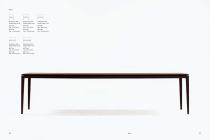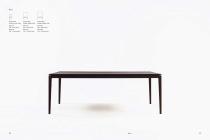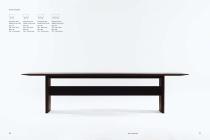
Catalog excerpts

Time & Style ē dition The sensitive light chair A chair outside the cage Imperial family Japanese chair Liku Japanese chair Chair / Armchair Silent cabinet Silent drawer Silent drawer – cabinet Silent wardrobe Open cabinet
Open the catalog to page 3
Time & Style ēdition The Time & Style ē dition developed for Boffi | De Padova presents a contemporary evolution of traditional Japanese wood craftsmanship. For over two decades, Japanese design brand Time & Style has gone to great lengths to promote the country’s long-standing traditions and skills linked to carpentry. In the forests of Hokkaido, the northernmost of Japan’s main islands, the freezing winters slow the growth of trees, permitting the development after many years of high quality, dense timber. Time & Style taps into time-honored customs practiced by artisans involved in the...
Open the catalog to page 4
The sensitive light chair The sensitive light chair - BDTI-001 Beech – Snow white Fabric – Grey - BDTI-005 Beech – Snow white Fabric – Grey - BDTI-002 Beech – Snow white Leather – Dark brown - BDTI-006 Beech – Snow white Leather – Dark brown - BDTI-003 Beech – Charcoal grey Fabric – Grey - BDTI-007 Beech – Charcoal grey Fabric – Grey - BDTI-004 Beech – Charcoal grey Leather – Dark brown - BDTI-008 Beech – Charcoal grey Leather – Dark br
Open the catalog to page 5
The sensitive light chair The sensitive light chair aims to be delicate and compact, exuding a calm and neat presence. It was envisaged as a lightweight chair that combines strength with durability. It is light enough for anyone to carry with one hand from room to room or upstairs to a different floor. Chair designs are often said to express the identity of their designer or architect. In most cases, those chairs themselves suggest existence. Time & Style believes that a chair should not excessively exert its presence but rather a more modest and low-key air. For the design of The sensitive...
Open the catalog to page 6
A chair outside the cage W497×D517×H761×SH455 - BDTI-101 Beech – Snow white Fabric – Grey - BDTI-102 Beech – Snow white Leather – Dark brown - BDTI-103 Beech – Charcoal grey Fabric – Grey - BDTI-104 Beech – Charcoal grey Leather – Dark brown W497×D517×H761×SH455 - BDTI-105 Beech – Snow white Fabric – Grey Rattan - BDTI-106 Beech – Snow white Leather – Dark brown Rattan - BDTI-107 Beech – Charcoal grey Fabric – Grey Rattan - BDTI-108 Beech – Charcoal grey Leather – Dark brown Rattan
Open the catalog to page 8
The period of Japanese history from 16,000 years ago to 3,000 years ago is called the Jomon period. This was a time when the people lived with very little influence from China or the Asian continent. During this period, the people did not eat cultivated rice, but instead ate nuts from primeval broadleaf forests as their staple food. Their diet also included forest animals and fish from the sea and rivers. Jomon people were very much ‘folk of the forest’. Although rice cultivation was introduced to Japan and rice became the staple Japanese food, the people have continued to have a symbiotic...
Open the catalog to page 9
A chair outside the cage Whilst the outline is the same as A chair in the forest, A chair outside the cage utilises a rattan panel in the backrest to instill it with lightness. The characteristics of this chair is wide space of the backrest and the seat but by incorporating rattan, it becomes lighter in both appearance and weight. It has a modern colonial feel and creates a slightly nostalgic atmosphere. The fusion of styles also illustrates the connection between Japan and Southeast Asia. By keeping the overall chair outline and changing only the material, the theme of this chair is the...
Open the catalog to page 10
Rectangular table Rectangular table Rectangular table Rectangular table Rectangular table
Open the catalog to page 12
Square table Square table Square table
Open the catalog to page 13
Round table Round table Round table Round table Round table
Open the catalog to page 14
This table was born from a process wherein they shaped the wood by hand, understanding its unique characteristics by touch until they discovered the form within. Time & Style wanted to create a style that could harmonise with any type of space, the soft curve of the natural wood existing in concert with the presence of modernity. One of the characteristics of Japanese design was the presence of these simple cubes, and that gave birth to a balance, a simple and clean design ethic. Crucial to this cube-based design structure were the sharp corners that formed where three faces of the cube...
Open the catalog to page 15
Rectangular table Rectangular table Rectangular table Rectangular table
Open the catalog to page 17
The structure and design of this table is inspired by the torii archways that stand at the entrance of shrines. They signify the boundary between the everyday world and the holy precinct. The commonly encountered torii gates are a beautifully simple design that is impermeable to the strong winds, rains, and earthquakes that occur often in Japan. The materials are primarily the Japanese conifers, hinoki cypress or cedar, whose logs are used as the columns. The larger ones have columns wider than 60–80cm in diameter, with the age of the tree between 100–500 years old. The structure consists...
Open the catalog to page 18
Japan has more than 70,000 Buddhist temples. Buddhism originated in India and blossomed in China and Korea before making its way to Japan’s shores some 1,500 years ago. Japan sent many emissaries to China to learn about its culture and ideologies. They returned to the country and spread architecture, art, crafts, and other technologies. Much of the Buddhist architecture acquired during that era remains beautiful in form even to this day. Touhaku District in Shimane Prefecture is the location of Mt. Mitoku Sanbutsuji Temple, built from 706 to 849 AD. At the deepest recesses of the temple...
Open the catalog to page 21
Imperial family
Open the catalog to page 24
Imperial family The Japanese Imperial family has existed for 126 generations and 2,700 years as unbroken imperial line, from Emperor Jimmu, the legendary first Emperor of Japan, to the present day monarch. The Emperor of Japan represents both the history of the country and the origin of its people. This unbroken 2,700 year dynasty is the intrinsic context in which much of modern Japanese culture and craftsmanship exists, and as such cannot be avoided in any discussion of those. While each table may differ in size and height, the placement of a series of these round tables can create a...
Open the catalog to page 25All DePadova catalogs and technical brochures
-
Étiquette Outdoor
5 Pages
-
When Water Meets
50 Pages
-
Interiors Worldwide
170 Pages
-
Urban Living Spaces No.2
46 Pages
-
2020 NEW Collection
100 Pages
-
Book
1 Pages
-
Campo Arato
2 Pages
-
Chab-table
1 Pages
-
Console
1 Pages
-
Dan
2 Pages
-
Dt Light
2 Pages
-
Firefly
2 Pages
-
Ishi
1 Pages
-
Keel
1 Pages
-
Mate
1 Pages
-
Mini Mate
1 Pages
-
Moby 2
1 Pages
-
Mogura
2 Pages
-
Narciso
1 Pages
-
Prêt-à-porter
1 Pages
-
Quadrato Espositore
1 Pages
-
Rokumaru
1 Pages
-
Scrittarello
1 Pages
-
Sen
2 Pages
-
Tetris
2 Pages
-
Sleeping Car
1 Pages
-
Asseman Open
2 Pages
-
Asseman
2 Pages
-
Vidun
2 Pages
-
Tavolo '95
2 Pages
-
Shine
3 Pages
-
Quadrato
1 Pages
-
Otis
1 Pages
-
Campo D'oro
2 Pages
-
Uragano
1 Pages
-
Sundance
1 Pages
-
Silver
5 Pages
-
Marocca
1 Pages
-
Lavenham Executive
3 Pages
-
Incisa
3 Pages
-
Donzella
2 Pages
-
Cirene
2 Pages
-
Chesto
1 Pages
-
Railway Outdoor
2 Pages
-
Silver Outdoor
2 Pages
-
Tools 16 2002/2015
2 Pages
-
Tattomi Jan Armgardt 1985
2 Pages
-
Albereta Philippe Nigro 2015
2 Pages



















































